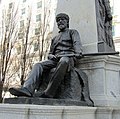
Brigham Young was an American religious leader and politician. He was the second president of the Church of Jesus Christ of Latter-day Saints, from 1847 until his death in 1877. During his time as church president, Young led his followers, the Mormon pioneers, west from Nauvoo, Illinois, to the Salt Lake Valley. He founded Salt Lake City and served as the first governor of the Utah Territory. Young also worked to establish the learning institutions that would later become the University of Utah and Brigham Young University. A polygamist, Young had at least 56 wives and 57 children. He instituted a ban prohibiting conferring the priesthood on men of black African descent, and led the church in the Utah War against the United States.
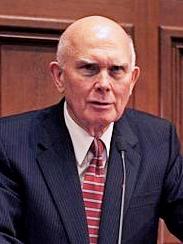
Dallin Harris Oaks is an American religious leader and former jurist and academic who since 2018 has been the first counselor in the First Presidency of the Church of Jesus Christ of Latter-day Saints. He was called as a member of the church's Quorum of the Twelve Apostles in 1984. Currently, he is the second most senior apostle by years of service and is the President of the Quorum of the Twelve Apostles.
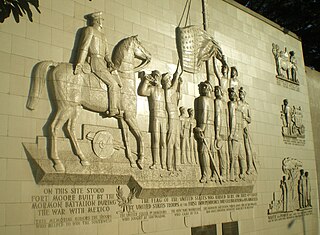
The Mormon Battalion was the only religious unit in United States military history in federal service, recruited solely from one religious body and having a religious title as the unit designation. The volunteers served from July 1846 to July 1847 during the Mexican–American War of 1846–1848. The battalion was a volunteer unit of between 534 and 559 Latter-day Saint men, led by Mormon company officers commanded by regular U.S. Army officers. During its service, the battalion made a grueling march of nearly 2,100 miles from Council Bluffs, Iowa, to San Diego, California.

The Mormon Trail is the 1,300-mile (2,100 km) long route from Illinois to Utah on which Mormon pioneers traveled from 1846–47. Today, the Mormon Trail is a part of the United States National Trails System, known as the Mormon Pioneer National Historic Trail.

Pioneer Day is an official holiday celebrated on July 24 in the American state of Utah, with some celebrations taking place in regions of surrounding states originally settled by Mormon pioneers. It commemorates the entry of Brigham Young and the first group of Mormon pioneers into the Salt Lake Valley on July 24, 1847, where the Latter-day Saints settled after being forced from Nauvoo, Illinois, and other locations in the eastern United States. Parades, fireworks, rodeos, and other festivities help commemorate the event. Similar to July 4, many local and all state-run government offices and many businesses are closed on Pioneer Day.

This is the Place Heritage Park is a Utah State Park that is located on the east side of Salt Lake City, Utah, United States, at the foot of the Wasatch Range and near the mouth of Emigration Canyon. A non-profit foundation manages the park.
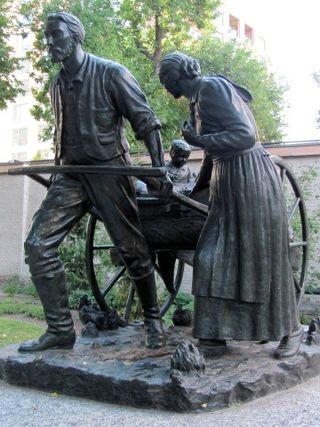
The Mormon pioneers were members of the Church of Jesus Christ of Latter-day Saints, also known as Latter Day Saints, who migrated beginning in the mid-1840s until the late-1860s across the United States from the Midwest to the Salt Lake Valley in what is today the U.S. state of Utah. At the time of the planning of the exodus in 1846, the territory was part of the Republic of Mexico, with which the U.S. soon went to war over a border dispute left unresolved after the annexation of Texas. The Salt Lake Valley became American territory as a result of this war.

Cyrus Edwin Dallin was an American sculptor best known for his depictions of Native Americans. He created more than 260 works, including the Equestrian Statue of Paul Revere in Boston; the Angel Moroni atop Salt Lake Temple in Salt Lake City; and Appeal to the Great Spirit (1908), at the Museum of Fine Arts, Boston. He was also an accomplished painter and an Olympic archer.

Jane Elizabeth Manning James, fondly known as "Aunt Jane", was an early African-American member of The Church of Jesus Christ of Latter-day Saints and traveled to Utah as a pioneer. She lived with Joseph Smith and his family for a time in Nauvoo, Illinois. She traveled with her family to Utah, spending the winter of 1846–1847 at Winter Quarters, and was among the first of the pioneers to enter the Salt Lake Valley in 1847. As a black woman, James was not allowed to enter the temple during her lifetime and petitioned the First Presidency of the church multiple times to be endowed and sealed. As a result of her requests she was adopted as a servant into the family of Joseph Smith through a specially-created temple ceremony. She was posthumously endowed by proxy in the Salt Lake Temple in 1979.

The This is the Place Monument is a historical monument at the This is the Place Heritage Park, located on the east side of Salt Lake City, Utah, at the mouth of Emigration Canyon. It is named in honor of Brigham Young's famous statement in 1847 that the Latter-day Saint pioneers should settle in the Salt Lake Valley. Mahonri M. Young, a grandson of Brigham Young, sculpted the monument between 1939 and 1947 at Weir Farm in Connecticut. Young was awarded $50,000 to build the monument in 1939 and he was assisted by Spero Anargyros. It stands as a monument to the Mormon pioneers as well as the explorers and settlers of the American West. It was dedicated by LDS Church President George Albert Smith on 24 July 1947, the hundredth anniversary of the pioneers entering the Salt Lake Valley. It replaced a much smaller monument located nearby.
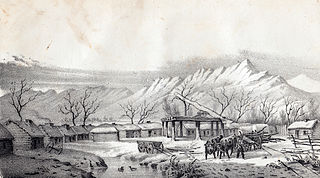
Fort Utah was the original white settlement at Provo, Utah, United States, and was established March 12, 1849. The original settlers were President John S. Higbee and about 30 families or 150 persons that were sent from Salt Lake City to Provo by President Brigham Young. Several log houses were erected, surrounded by a 14-foot (4.3 m) palisade 20 by 40 rods in size, with gates in the east and west ends, and a middle deck, for a cannon. The fort was first located west of town, but was moved to Sowiette Park in April 1850.
Miles Morris Goodyear was an American fur trader and mountain man who built and occupied Fort Buenaventura in what is now the city of Ogden, Utah. The fort was located approximately two miles south of the confluence of the Weber and Ogden rivers and about one-quarter mile west of the end of Ogden's modern 28th Street. Goodyear was the first recorded man of European descent to live in the Weber Valley of Utah.

Edward J. Fraughton is an American artist, sculptor, and inventor. He is primarily known for his epic monumental works and individual collector editions that often relate to the history of the American West. Fraughton's stylistic goals follow the American Neo-classic/Beaux-Arts, impressionistic realism traditions of J. Q. A. Ward, Henry Merwin Shrady, James Earle Fraser, Hermon Atkins MacNeil, Daniel Chester French, Augustus Saint Gaudens, Cyrus Dallin, Gutzon and Solon Borglum, and American animaliers Arthur Putnam, Edward Kemeys, Phimister Proctor. A literal sculptor with an academic background in design and human anatomy, Fraughton's versatility covers a broad spectrum of human and animal subjects.

The Eagle Gate monument is a historical monument—more in the form of an arch than a gate—seventy-six feet across, situated at the intersection of State Street at South Temple, adjacent to Temple Square, in Salt Lake City, Utah.

Torleif Severin Knaphus was a Norwegian-born artist and sculptor in Utah, primarily known for sculptures for and about the Church of Jesus Christ of Latter-day Saints.

The Mormon Pioneer Memorial Monument is a private cemetery and memorial. It is the burial site of Brigham Young, and his legal, non-plural wife, Mary Ann Angell, along with other wives and family members. Part of the property was dedicated to the Mormon pioneers who died making the journey to Utah from Illinois and other parts of the world between 1847 and 1869.

Erected in 1930, the Sugar House Monument has long stood as a testament to the hard work of early Salt Lake pioneers making the valley sustainable.

Brigham Young is a marble statue by Mahonri Young representing the Mormon religious leader of the same name, installed in the United States Capitol, in Washington D.C., as part of the National Statuary Hall Collection. It is one of two statues donated by the state of Utah, and is unusual in the collection in that Young is portrayed sitting down. The statue was unveiled by Alben William Barkley on June 1, 1950.


